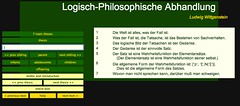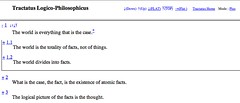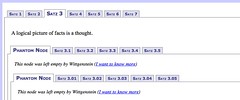Since Wittgenstein's Tractatus is written in a numerical hierarchy, it has often been the subject of simple hypertext projects like our own. We were surprised that our design values differed significantly from these projects. We were equally delighted to see how other designers approached those goals.
David and I decided to focus our design on comparison and flow, to match Wittgenstein's stated intentions. In a footnote, he explains that the hierarchy is intended to emphasize relative importance and sequence. Furthermore, the text's didactic style needs explicit structure if it is to be anything greater than a collection of aphorisms. An interface which permits comparison and flow provides that structure.
More information about our designs will be available in the next few weeks on The Hacktatus main page.
Our focus on comparison and flow seemed the opposite of other designers, who tend to hide context and break up the text.
When compared to print editions (which simply present the Tractatus in order), current online designs focus radically on the individual sections of the Tractatus. In addition, most the online editions permit users to
- Click to see the immediate child
- Click to see the immediate parent
- Read some next/previous statements of a similar importance
Few of the following designs permit the tracing of a term or concept through the text. They use Wittgenstein's numbers to donote the current location. And short of opening up two web browser windows, none of them the permit comparison of sections.
Nonetheless, all of these designs work well on a large variety of web browsers. Laventhol's design has survived on the web for nearly 15 years.
Here is the list of hypertext editions of the Tractatus which we reviewed. (one is missing- help, Dave?):
-
 Jaap van der Does uses a javascript toolbar and search to help readers navigate his plain text version of the Tractatus.
Jaap van der Does uses a javascript toolbar and search to help readers navigate his plain text version of the Tractatus. -
 Satoh Sin has made an English-Japanese edition which employs stretchtext. This design is innovative for its use of horizontal and vertical rules to indicate the expansion level.
Satoh Sin has made an English-Japanese edition which employs stretchtext. This design is innovative for its use of horizontal and vertical rules to indicate the expansion level. -
 Luciano Bazzocchi, who was a PhD student at the University of Pisa, has posted a linked web version of the Tractatus on his website. He has also written scholarly articles on the Tractatus Hypertext, and Wittgenstein's writing habits. Bazzocchi is the only actual Wittgenstein scholar we know who has produced a hypertext edition.
Luciano Bazzocchi, who was a PhD student at the University of Pisa, has posted a linked web version of the Tractatus on his website. He has also written scholarly articles on the Tractatus Hypertext, and Wittgenstein's writing habits. Bazzocchi is the only actual Wittgenstein scholar we know who has produced a hypertext edition. -
 Jonathan Laventhol created a hypertext edition of the Ogden translation of the Tractatus. Like us, Laventhol added empty notes into the Tractatus to present a consistent structure. Laventhol is the edition which has been around the longest, is the most convention, bug free, and therefore is the most linked on scholarly websites. Laventhol has also produced a beautiful Site Map of the Tractatus.
Jonathan Laventhol created a hypertext edition of the Ogden translation of the Tractatus. Like us, Laventhol added empty notes into the Tractatus to present a consistent structure. Laventhol is the edition which has been around the longest, is the most convention, bug free, and therefore is the most linked on scholarly websites. Laventhol has also produced a beautiful Site Map of the Tractatus. -
 PhiloSURFical is a strange and wonderful (and abandoned) Semantic Web system by Michael Pasin which shows the Tractatus in tabs.
PhiloSURFical is a strange and wonderful (and abandoned) Semantic Web system by Michael Pasin which shows the Tractatus in tabs.
There are also several phantom editions at the time of writing ( 9 Sept 2010).
- The Chicago Philosophy Project list refers to an edition which resided on the University of Oxford web servers at one time (http://midas.thphys.ox.ac.uk:8001/the_tractatus)
Additional notes:
- We think it's fascinating that Terry Eagleton wrote extensively about Wittgenstein.
- We are sad that so many big lists of Wittgenstein resources are out of date.


